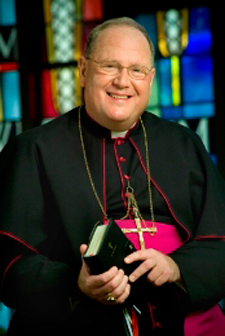NYC's archbishop, in digital and analog
 An interesting questions that my students keep asking about Internet journalism is whether information that is printed in online publications -- as opposed to ink-on-paper text -- is "real." What does "real" mean?
An interesting questions that my students keep asking about Internet journalism is whether information that is printed in online publications -- as opposed to ink-on-paper text -- is "real." What does "real" mean?
Simply stated, if information appears in a post in a New York Times weblog, does that mean that the information "ran" in the Times? Is it accurate to describe it with that magical phrase, "according to the New York Times"?
Take, for example, this fascinating fragment from the installation rites for Archbishop Timothy M. Dolan as the 13th Roman Catholic bishop (and 10th archbishop) of New York, focusing on Mayor Michael Bloomberg:
(Mayor Bloomberg's eyes had been flitting between the archbishop in the pulpit, and the flower-laden altar, which he fixed with a blank stare. He had been chewing gum the whole time, but when the archbishop began speaking his few sentences in Spanish, Mr. Bloomberg -- who has taken Spanish lessons himself -- gave the man of the hour his full attention, and stopped working his jaw.)
Clearly, this is from the weblog coverage. It's "bloggy." But is it "real"?
In the old days, reporters at major events were often asked to produce what were called "reporter's notebook" features, which gathered together all kinds of odds and ends that ordinarily would not run in the newspaper. That's what the weblog stuff is all about, full of a hundred extra adjectives, images of elderly priests nodding off, riffs about "The bishop dude!" and an extra "Whoo-hoo!"
However, in the old days, these "notebook" stories would, and this is the point, run in the newspaper after these special events -- thus making them "real." Here is my question for our readers who live in New York City: Did the state of the mayor's gum make it into the dead-tree-pulp final edition?
This kind of inside-baseball question becomes more important, I think, when you get to the heart of a story, which in this kind of event means, of course, when things get political.
Thus, the weblog account describes the crucial moment of the Dolan homily this way:
In his first mention of social issues, the newly installed archbishop drew sustained applause and a standing ovation -- but not from everyone -- when he spoke of the need to protect "the sanctity of human life," specifically "the tiny baby in the womb." He quoted a predecessor, Cardinal Terence Cooke, as saying that human life is no less worthy just because it is tiny, weak or sick.
"See, what we're saying is that everybody in this great mega-community is a somebody, with an extraordinary destiny," he said, continuing, "That's why the church reaches out to the unborn, the suffering, the poor, our elders, the physically or emotionally challenged, and those caught in the web of addiction."
In the "real" story (at least, the one I will assume is real), we get this:
He defined himself as advocate in chief for the Catholic view -- opposed to abortion, opposed to same-sex marriage, in support of people in need -- but as a teacher and pastor, not a polemicist. He seemed, at first blush, like the Mike Huckabee of American bishops. Mr. Huckabee, the former Republican presidential candidate, describes himself as the conservative who is "not mad at anybody."
And like Mr. Huckabee, a Baptist minister, the new archbishop displayed a firm grasp of the art of the preacher. During his homily, he made them laugh, hit notes of poignancy, and brought them to their feet when he declared with percussive rhythmic emphasis the church's mission "to embrace and protect the dignity of every human person, the sanctity of human life, from the tiny baby in the womb, to the last moment of natural passing into eternal life."
 Honestly, I don't know quite what to do with the insertion of Huckabee into a story about an Irish prelate moving to New York, but I can kind of see the point. That's the kind of language that one normally sees in analysis pieces, but maybe that's the rising tide these days.
Honestly, I don't know quite what to do with the insertion of Huckabee into a story about an Irish prelate moving to New York, but I can kind of see the point. That's the kind of language that one normally sees in analysis pieces, but maybe that's the rising tide these days.
My main impression is that the weblog piece simply has more information in it because there's more room in which to maneuver. Duh.
Some of that extra info is kind of strange, but some of it adds real content -- such as the full quote that clearly lays out Catholicism's teachings on the dignity of every human person, using the practical examples that the archbishop actually used in his text.
So here is my question for our Catholic readers (and others who are careful readers of coverage of the Church of Rome): Which piece do you prefer? The "real" story or the bloggy version? Digital or analog? Which version do you think does more justice to the content of Dolan's homily, in particular? Have you seen a mainstream news report that does a better job?
Of course, answering that question would require access to the full text: So here it is.
Please chime in. And no Times bashing please. Pretend that you're Archbishop Dolan or even, heck, Huckabee.